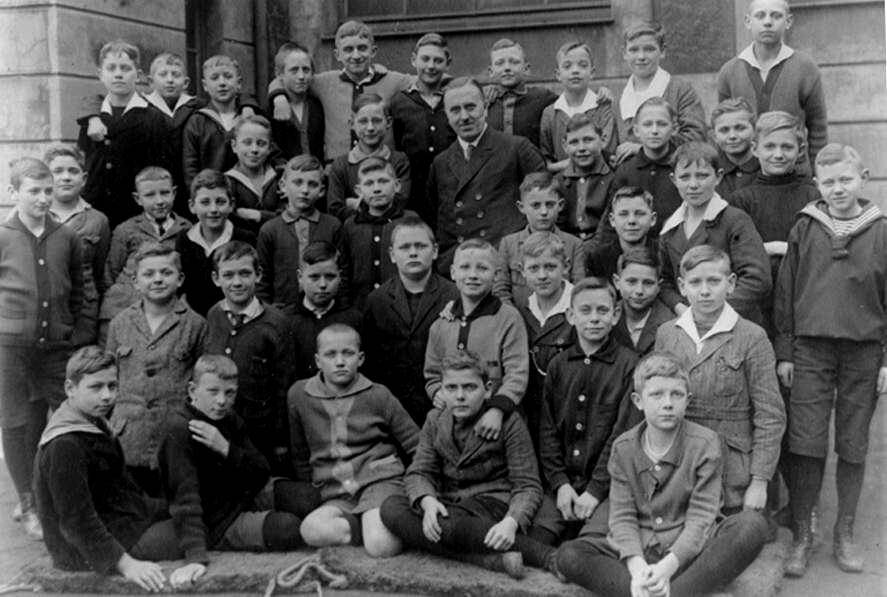
German School System: Photographic Record

Figure 1.--There was no indormation attached to this school clss portrai (figure 1). The boys look to us to be about 11-years old. That would mean that it was a year after the last year of Volksscule. We think it was a city school because it is an all boys class. Dating the imafe is fairly easy. We think it was taken in the early-1920s, The short- cropped hair and the long stockings, both suggest the early-20s as do the sweaters.
|
|
Unfortunately many images we have acquired do not identify the school. Thus we often are not sure just what kind of school we are deling with. We are usually able to date the images and tell tge agevof the children, but figuring out the type of school is a little more complicated because children of the same age were in different kinds of schools. Here before World War II, social class was a major factor. We have decided to post some of these images in the hope that our German readers will be able to provide some insights to help identify some of these images.
Unidentified 11-year old class (early-1920s)
There was no indormation attached to this school clss portrai (figure 1). The boys look to us to be about 11-years old. That would mean that it was a year after the last year of Volksscule. We think it was a city school because it is an all boys class. Dating the imafe is fairly easy. We think it was taken in the early-1920s, The short- cropped hair and the long stockings, both suggest the early-20s as do the sweaters. Also notice the long length of the short pants. The rather informal clothing to us suggests working-class boys which would mean a primary school and not a secondary school like a gymnsium. A reader, however, writes, "These German schoolboys apparently belong to a Gymnasium, a school for academically minded boys with a traditional curriculum. These schools were generally segregated by gender in the 1920s. We see some sailor suits. Nearly all the boys wear short trousers with long black stockings, but at least one boy wears knee socks and has bare knees. Notice also the Schiller collars, open-necked white shirts.
I think our reader believes the single-gender class suggests a gynasium. We think that this often means a city school. Most mixed classes in the 1920s were rural or small town classes that did not have big enough populations to separate genders.
These boys seem to be about 11-12 years old. A German reader writes, "I don't see a special indication for Gymnasium. They are not wearing gymnasium caps but still it could be (or not)." The absence of caps could reflect the fact that the boys were in class and only came out to have the portrait taken.
HBC

Related Chronolgy Pages in the Boys' Historical Web Site
[Main Chronology Page]
[The 1880s]
[The 1930s]
[The 1940s]
[The 1950s]
[The 1960s]
[The 1970s]
[The 1980s]
Related Style Pages in the Boys' Historical Web Site
[Main school uniform page]
[Main country page]
[Long pants suits]
[Short pants suits]
[Socks]
[Eton suits]
[Jacket and trousers]
[Blazer
[School sandals]
Navigate the Boys' Historical Clothing School Uniform Pages
[Return to the Main German school system page]
[Return to the Main German school level page]
[Main German school uniform Page]
[Australia]
[England]
[France]
[Italy]
[Japan]
[New Zealand]
[Scotland]
[United States]
Navigate the Boys' Historical Clothing Web Page
[Introduction]
[Activities]
[Biographies]
[Chronology]
[Clothing styles]
[Countries]
[Bibliographies]
[Contributions]
[FAQs]
[Glossaries]
[Images]
[Links]
[Registration]
[Tools]
[Boys' Clothing Home]
Created: 4:36 AM 5/28/2011
Last updated: 4:36 AM 5/28/2011



